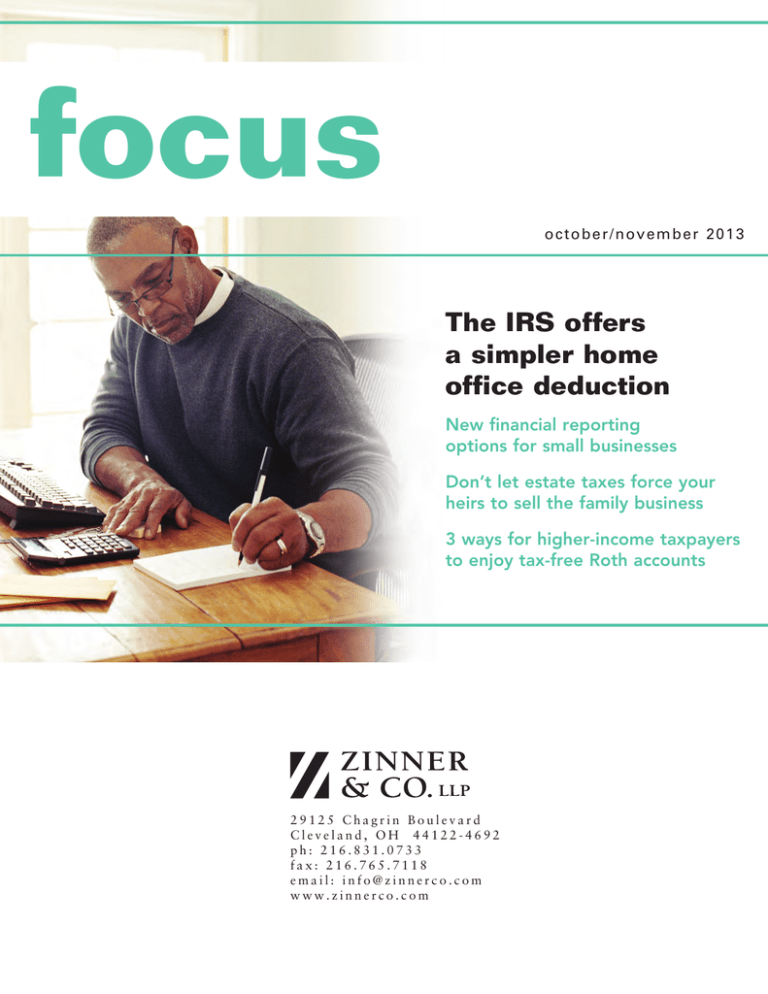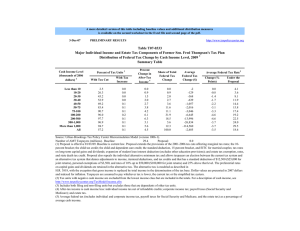The IRS offers a simpler home office deduction
advertisement

focus oct ober/nov em b er 2013 The IRS offers a simpler home office deduction New financial reporting options for small businesses Don’t let estate taxes force your heirs to sell the family business 3 ways for higher-income taxpayers to enjoy tax-free Roth accounts 29125 Chagrin Boulevard Cleveland, OH 44122-4692 ph: 216.831.0733 fax: 216.765.7118 email: info@zinnerco.com www.zinnerco.com The IRS offers a simpler home office deduction I f you’re one of the approximately 3.4 million U.S. taxpayers who claim a home office deduction on your tax return, you may find the calculations a bit easier going forward. Vive la difference! Earlier this year, the IRS announced a simplified option, also known as the “safe harbor” option, for calculating the home office deduction. You can use the new option in tax years that begin on or after Jan. 1, 2013. Under the simplified option, home-related itemized deductions that previously were split between Schedule A (“Itemized Deductions”) and Schedule C (“Profit or Loss From Business”), such as property taxes, now generally are claimed on Schedule A. In other words, these expenses aren’t allocated between personal and business use, as they are with the regular method. Making it easy Under the simplified option, you multiply the actual square footage within your home that’s used for your business by the prescribed rate of $5 per square foot, up to a maximum of 300 square feet. Thus, the deduction is effectively capped at $1,500 per year, although the IRS may change the $5 per square foot rate in the future. The new method is optional. If you prefer, you can continue to use the traditional method, calculating your actual home office expenses, such as the portion of utilities and repairs allocable to your home office. You can use either method for any tax year. However, once you choose a method for a particular year, you can’t change it. The simplified option differs from the regular method of calculating a home office deduction in several ways. The deduction is effectively capped at $1,500 per year, although the IRS may change the $5 per square foot rate in the future. In addition, the simplified option doesn’t allow a separate depreciation deduction for the portion of your home that’s used for business. But you can still deduct business expenses unrelated to your home office space (such as marketing expenses) and direct home office expenses (such as a business-only phone line and office supplies). If you’re self-employed, the amount you claim under the simplified option can’t exceed the gross income from your business, less any expenses. Moreover, you can’t carry forward any unused portion of the deduction to a future year. This differs from the regular method, which does allow a carryforward. 2 If you’re an employee, whichever method you use, you’ll enjoy a tax benefit only if your home office deduction plus your other miscellaneous itemized deductions exceed 2% of your adjusted gross income. More calculation considerations Keep in mind that, if you begin using a home office partway through the year, you’ll need to calculate what’s known as the “average monthly allowable square footage.” Say you start a business on Aug. 1 and use 300 square feet of space. The allowable square footage would be 125, or 300 square feet divided by 12 months in a full year multiplied by the five months of August to December: (300/12) × 5 = 125. In addition, if you and your spouse use different areas of the home for separate businesses, you each can use the simplified option — but you must use it for all your businesses, taking a deduction for only up to 300 square feet total, reasonably allocated between your businesses. Qualifying for the deduction The simplified option doesn’t change the criteria that determine whether you can claim a home office deduction. The deduction generally is allowed only when you use a portion of your home exclusively and on a regular basis for business purposes. In addition, if you’re self-employed, your home office generally must be your company’s principal place of business, although you may also conduct business elsewhere. If you’re an employee, your use of the home office must be for your employer’s benefit. Which is better? The simplified option makes calculating the home office deduction easier, but, depending on your situation, you might save more tax by sticking with the regular method. Your tax advisor can provide insight and information and help you determine if the simplified option is right for you. ± Home office deduction just one potential AMT trigger The alternative minimum tax (AMT) is a separate tax system that doesn’t allow certain deductions and that treats some income items differently. If your AMT liability exceeds your regular income tax liability, you must pay the AMT. For employees who qualify for the home office deduction, that deduction can trigger the AMT. How? It’s a miscellaneous itemized deduction subject to the 2% floor (see main article), and such deductions aren’t allowed for AMT purposes. Professional fees, investment expenses and other unreimbursed employee business expenses are additional miscellaneous itemized deductions subject to the floor. Other deductions that can trigger the AMT include: • State and local income taxes or state and local sales taxes, • Property tax, and • Interest on home equity debt not used to improve your principal residence. Fortunately, the AMT may now be less of a threat because higher AMT exemption amounts, as well as inflation-indexing of the AMT brackets, have been made permanent. 3 New financial reporting options for small businesses I f you own and run a small, privately held business, reporting your financial performance usually means choosing between Generally Accepted Accounting Principles (GAAP) and special purpose frameworks, more commonly known as other comprehensive basis of accounting (OCBOA). OCBOA has been an alternative to GAAP for more than 40 years, allowing smaller businesses to use a cash basis or tax basis of accounting to report financial results. In June, the American Institute of Certified Public Accountants (AICPA) introduced a new OCBOA called the “Financial Reporting Framework for Small- and MediumSized Entities” (FRF for SMEs). This 206-page framework is designed to be a nonauthoritative blend of traditional accounting and accrual income tax accounting. Meanwhile, the Private Company Council (PCC), which works under the auspices of the Financial Accounting Foundation (FAF), has been issuing proposals designed to simplify accounting for private companies that report according to GAAP. The FRF for SMEs differs from GAAP in a number of ways. For instance, it uses historical cost as the primary measurement basis, rather than fair value. In addition, because many small businesses have limited resources, the framework isn’t expected to undergo frequent amending. However, it will be updated when significant developments affect financial reporting by small and midsize entities. The goal of the FRF for SMEs is to provide a streamlined, cost-effective financial reporting solution for businesses that aren’t required to use GAAP. It’s designed to address transactions encountered by small and midsize, private, for-profit entities, and to show the business’s profitability, assets and available cash. Words of caution: The National Association of State Boards of Accountancy (NASBA), which works with accounting regulators and practitioners, has said it supports modifying GAAP to meet the needs of private companies but doesn’t support the FRF for SMEs. Instead, NASBA advocates following GAAP standards for private companies once they are issued by the Financial Accounting Standards Board (FASB). A company doesn’t have to meet a specific definition of a small business to use the FRF for SMEs, and use of the framework is optional. Management and other stakeholders in a company can determine whether the Regardless of whether you choose GAAP or an OCBOA such as the FRF for SMEs, it’s a good idea to use a CPA to help navigate the rules. OCBOA statements can be audited, reviewed or compiled by a CPA just like GAAP The FRF for SMEs 4 framework is appropriate for the entity and, if so, begin using it immediately. financial statements to provide added credibility and assurance. The PCC The PCC was established in 2012 to improve the process of setting accounting standards for private companies that prepare GAAPbased financial statements. Before being incorporated into GAAP, this and other PCC proposals are subject to a FASB endorsement process. FASB has endorsed three proposals that would: 1.Provide relief from requirements that certain intangible assets required in a business combination, such as a merger, be separately recognized, 2.Allow the amortization of goodwill and a simplified goodwill impairment model, and A company doesn’t have to meet a specific definition of a small business to use the FRF for SMEs, and use of the framework is optional. 3.Allow two simpler approaches to accounting for certain types of interest rate swaps when a private company intends to economically convert the interest rate on its debt from variable to fixed. It has two broad areas of responsibility: One is determining whether and how existing nongovernmental GAAP should be modified to better meet the needs of users of private company financial statements. Options for private companies The other is advising FASB on the appropriate treatment for private companies when it comes to new items that are under consideration. As of this writing, these proposals have not been implemented by FASB. Until the proposals become official, private firms that choose GAAP must continue to follow the same reporting requirements as their public counterparts. For more information on ongoing developments with the FRF for SMEs and the PCC’s work, go to fasb.org/pcc and aicpa.org. And be sure to consult with your accounting professional. He or she can help you understand the financial reporting options for private companies. ± Don’t let estate taxes force your heirs to sell the family business M any family business owners spend years nurturing their companies with the goal of providing a livelihood for their heirs. But often their estates don’t have enough cash to pay estate taxes and other expenses after they die, which can force the family to sell the business. If you’re concerned that your heirs will face this predicament, ask your financial advisor about Internal Revenue Code Section 6166. It allows a portion of the estate tax to be deferred. The 35% test If you’re an owner of a closely held business and a citizen or resident of the United States at the time of your death, your estate can 5 potentially qualify for Sec. 6166 treatment. The test is whether the value of the interest in your business exceeds 35% of your adjusted gross estate. There are a few rules to consider when applying the 35% test. If you’re a sole proprietorship, only the assets used in the company are considered when valuing the business. And the value of passive assets held by your business can’t be included in the valuation. If you have multiple companies, you must have owned at least 20% of each to combine the businesses for the 35% test. There’s also a general rule that businesses with more than 45 owners won’t qualify, although there are exceptions. The nuts and bolts If your estate qualifies for Sec. 6166 treatment, your heirs can pay the estate tax in two or more (but not exceeding 10) equal installments over 10 years. Plus, they can defer payment of the first tax installment for up to five years beyond the date it would have ordinarily been due. During the deferral period, interest must be paid annually. The first principal installment is due at the same time that the last interest-only payment is due. To minimize taxes and maximize cash flow, make sure your heirs understand the potential disadvantages of tax deferral under Sec. 6166. A special interest rate of 2% is available on the first $1 million in taxable value, which is adjusted annually for inflation. (For 2013, the deferral amount is $1.43 million.) Interest on any balance of the tax is assessed at 45% of the annual interest rate charged on 6 the underpayment of tax. With interest rates so low, as of this writing the special 2% rate is actually higher than the rate on the excess, which is currently a mere 1.35%. Sec. 6166 doesn’t apply to the entire amount owed on the estate. The amount of estate tax that may be paid in installments is the proportional amount attributable to the business’s value as compared to the amount of your adjusted gross estate. The remaining estate tax is due nine months after your death. Real estate qualifies as long as there’s been active management of the property — that is, if those assets are more than passive real estate investments. The negatives To minimize taxes and maximize cash flow, make sure your heirs understand the potential disadvantages of tax deferral under Sec. 6166. First, keep an eye on tax liens. To ensure that installment payments are made, the IRS will place a tax lien on your family business, and your estate will remain open and unresolved during the installment period. The greater the debt, the more likely it will adversely affect the company’s credit and hinder its ability to raise funds. Nonbusiness interest is another hotspot with the IRS. Deferred payments can’t be used to cover federal estate taxes for such interests. Your estate will need enough cash to pay for administrative expenses and accounting and legal fees for 14 years. It also will need sufficient liquidity to cover cash bequests, state death taxes, additional federal estate taxes, and interest and principal for the deferred estate tax. will be accelerated. For instance, the full balance will become due if the business is sold to someone who isn’t considered a “qualified” heir. If a scheduled payment is missed, the IRS can demand immediate payment of all unpaid taxes. Even if your estate pays the installments on time, there are certain circumstances under which the deferral is lost and the balance due Don’t let your family business perish under the weight of estate taxes after you’re gone. Work with a qualified financial and estate tax planner to ensure your family business continues to thrive. ± Work with a financial planner 3 ways for higher-income taxpayers to enjoy tax-free Roth accounts Roth IRAs offer substantial benefits. Although contributions aren’t deductible, qualified distributions are taxfree — the growth is never taxed. And unlike traditional IRAs, Roth IRAs have no required minimum distributions. So if you don’t need the money in retirement, you can let the entire balance grow tax-free to benefit your heirs. But modified adjusted gross income (MAGI)-based phaseouts limit who can contribute. For 2013, the phaseout ranges are: ® $178,000–$188,000 for married taxpayers filing jointly, and ® $112,000–$127,000 for singles and heads of households. You can make a partial contribution if your MAGI falls within the applicable range, but no contribution if it exceeds the top of the range. Fortunately, there are three ways higher-income taxpayers can still take advantage of Roth accounts: 1.Allocate your resources. Your employer may allow you to allocate some or all of your 401(k) plan contribution to a Roth account — and no income-based phaseout applies. In 2013, the 401(k) contribution limit is $17,500 ($23,000 if you’ll be age 50 or older on Dec. 31). Any employer match will be made to a traditional account. 2.Become a convert. If you have a traditional IRA, converting some or all of it to a Roth IRA may be beneficial. The converted amount is taxable in the conversion year, but future qualified distributions will be tax-free. There’s no longer an income-based limit on who can convert. 3.Knock on the back door. If you don’t have a traditional IRA, a “back-door” Roth IRA is an option: You set up a traditional IRA and make a nondeductible contribution (up to $5,500 in 2013, or $6,500 if you’ll be age 50 or older on Dec. 31). Once the transaction has cleared, you can convert to a Roth IRA and the only tax due will be on any growth from the contribution date to the conversion date. 7 This publication is distributed with the understanding that the author, publisher and distributor are not rendering legal, accounting or other professional advice or opinions on specific facts or matters, and, accordingly, assume no liability whatsoever in connection with its use. ©2013 FOCon13



